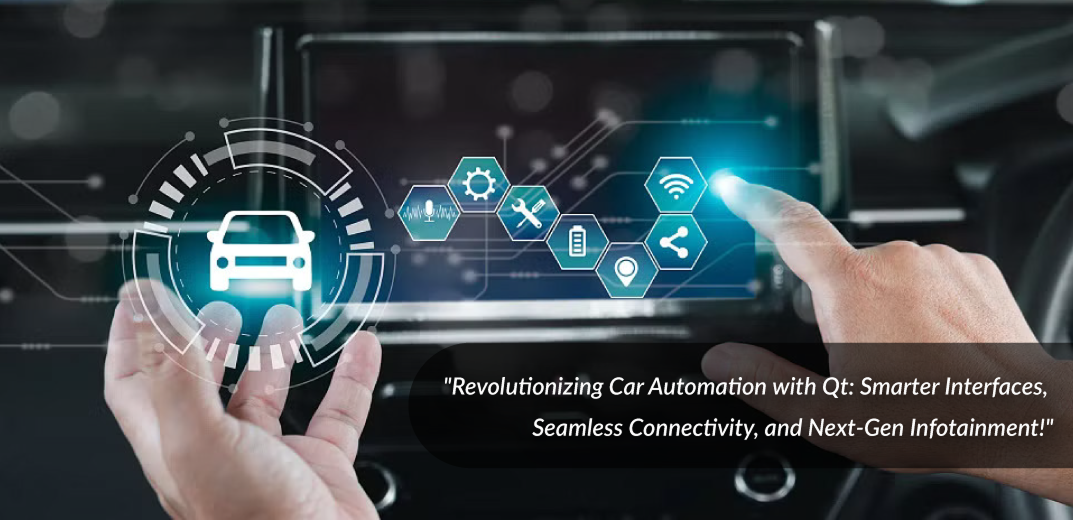Enhancing Car Automation with Qt: Smart, Scalable, and Interactive Solutions
Featured Blogs
Enhancing Car Automation with Qt: Smart, Scalable, and Interactive Solutions
"Think of a car where your dashboard, speedometer, infotainment system, and driver assistance features work seamlessly together. With Qt, automakers can create high-performance, visually stunning, and intuitive interfaces that enhance the driving experience." Qt, a powerful cross-platform development framework, is transforming car automation by enabling seamless infotainment systems, interactive dashboards, and advanced driver assistance systems (ADAS).
Categories

Enhancing Car Automation with Qt: Smart, Scalable, and Interactive Solutions
Qt simplifies automotive software development by providing a high-performance UI framework that supports real-time rendering, smooth animations, and cross-platform deployment. It enhances the driving experience by enabling intuitive, feature-rich interfaces for modern vehicles.
Key Qt Applications in
Automotive
- Infotainment Systems:
- Responsive touchscreens with fast, smooth
- UI-Integration with Android Automotive & Car-Play
- Customizable
themes and animations
- Digital Instrument Clusters:
- Real-time speedometers, fuel indicators, and dynamic UI elements
- High-resolution
displays with customizable
layouts
- Advanced Driver Assistance Systems (ADAS):
- Display for sensor data, lane detection, and navigation alerts
- Interactive 3D visualization of surrounding
- EV Monitoring & Control:
- Real-time battery status, energy tracking, and smart charging UI
- Custom
dashboards for electric and hybrid vehicles
Benefits of Using Qt for
Automotive UI Development
✅ Fast and Scalable UI –
Qt Quick & QML for real-time graphics
✅ Optimized for Embedded Systems
– Runs on low-power hardware
✅ Seamless Cross-Platform Deployment
– One framework for multiple devices
✅ Modern UX Design Tools
– Qt Design Studio for easy prototyping
How Dotcom IoT Enhances Car
Automation with Qt
At Dotcom IoT LLP, we
leverage Qt to build custom
automotive UI solutions tailored for infotainment, digital clusters, and
smart vehicle interfaces. - Qt-based embedded UI development for automotive applications
- Optimized software solutions for real-time performance
- Seamless integration with IoT and cloud platforms
- Qt-based embedded UI development for automotive applications
- Optimized software solutions for real-time performance
- Seamless integration with IoT and cloud platforms
Future of Qt in Automotive Automation ��
- The future of automotive UI is evolving rapidly, and Qt is set to play a major role in upcoming advancements, including:
- Enhanced 3D graphics for immersive dashboards – Smoother animations and real-time rendering for next-gen vehicle displays.
- Seamless connectivity with IoT & cloud – Real-time data sharing between vehicles, smart devices, and cloud-based services.
- More intuitive HMI (Human-Machine Interface) – Improved touch, voice, and gesture-based controls for effortless interaction.
- Optimized performance for electric & autonomous vehicles – Lightweight, high-speed UI frameworks tailored for future mobility solutions.
Recent Post
Get In Touch With Us
Are You Ready To Grow Your Business With Us?
Drop us a message
- Dotcom IoT : Headquarter
FW 3040, Bharat Diamond Bourse, BKC, Bandra Kurla Complex, Mumbai Suburban, Mumbai, Maharashtra, 400051, India. - Dotcom IoT : R&D Centre
410/4th Floor, Sunshine Commercial Complex, Hans Society, Mota Varachha, Surat, Gujarat 394101. USA
20W 47th ST, Suite#1501-A New York, NY 10036-3735.South Korea
369, Sangdo-Ro, Venture Center, Soongsil Univ., Dongjak-Gu Seoul, South Korea.- +91 85919 00346
- sales@dotcom.co.in





Tag:
#Qt#CarAutomation#ADASShare:
Tanvi Kukadiya is a Business Development Executive at Dotcom IoT LLP, specializing in strategic content, B2B outreach, and market research for IoT-based solutions.